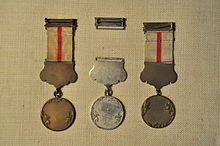Medal of Merit from the Red Crescent
The Ottoman medal known in Germany and Austria as the Medal of Merit of the Red Crescent (Ottoman: Osmanlı Hilâl-i Ahmer Cemiyeti Madalyası) was donated on October 15, 1912 by Sultan Mehmed V and consists of three classes: bronze , silver , gold . It was awarded to male and female members of both the Ottoman Empire and abroad for charitable work and services in the medical sector.
Appearance
The round medal mm in all three classes a diameter of about 28 and depends on a clasp , what the camera strap (white with a narrow red center stripe) with a further rectangular buckle (with safety pin for attaching to clothing) fastened.
On the front of the medal is a red enamelled crescent moon in the center in a round, white enamel field. Below is an olive branch, above the Ottoman inscription: "Help for the people". The reverse of the medal is smooth except for three flower tendrils.
The clasp on which the medal hangs is made in the material of the respective class and enameled in white rectangular shape in the upper part. In this enamel field is the Ottoman inscription: "Ottoman Society of the Red Crescent". In the non-enameled box, including the Tughra of Sultan "Abdul Mehmed Khan, son of Abdul Medjid Khan, always victorious." The back is smooth.
The clasp, which also forms the carrying clasp, is rectangular with semicircular drawn-in edges and also made of the material of the respective class. It is enamelled in white except for a narrow metal rim. The enamel field is usually not labeled. However, there are special versions with the inscription "1328-1329" (= years of the Hejra, which corresponds to the years 1912-1913). A locking pin is soldered to the back.
As an additional award for service in the war, an embossed oak leaf was awarded to clip onto the ribbon. It is implemented in the material of the respective class.
Carrying method
The medal was worn by men either individually or on a medal clasp on the left side of the chest.
For women there was a version with a ribbon bow that was worn on the dress below the left shoulder.
Award
The medal was awarded with an official certificate .
For the medals in bronze and silver, the proposal for awards came from the Executive Committee of the Society of the Red Crescent and had to be approved by at least one third of the members of the Central Committee of the Society.
For the gold medal, in addition to the approval of at least one third of the members of the central committee, the majority of a general assembly also had to approve the award.
Medals awarded to foreigners were delivered through the respective Ottoman embassy , in Germany also through the consulates general . In the course of the First World War , there were numerous awards to people from foreign allies of the Ottoman Empire.
literature
- Nuri Pere: Osmanlılarda Madenî Paralar. Yapı ve Kredi Bankasının Osmanlı Madenî Paraları Koleksiyonu = Ottoman metal coins. The collection of Ottoman metal coins from the building and Credit bank . Istanbul 1968, No. 1144 (p. 309 and plate 86).
- Metin Awarded: Osmanlı madalyaları ve nişanları. Belgelerle tarihi = Ottoman Medals and Orders. Documented history. The Destination Management Company, İstanbul 2001, ISBN 975-97637-0-2 (English and Turkish), p. 318.
- Edhem Eldem : Pride and Privilege. A History of Ottoman Orders, Medals and Decorations. Ottoman Bank Archive and Research Center, Istanbul 2004, ISBN 975-93692-8-1 , pp. 402ff.
Individual evidence
- ^ A b Edhem Eldem : Pride and Privilege. A History of Ottoman Orders, Medals and Decorations. Ottoman Bank Archive and Research Center, Istanbul 2004, ISBN 975-93692-8-1 , p. 402
- ↑ Edhem Eldem : Pride and Privilege. A History of Ottoman Orders, Medals and Decorations. Ottoman Bank Archive and Research Center, Istanbul 2004, ISBN 975-93692-8-1 , p. 413



